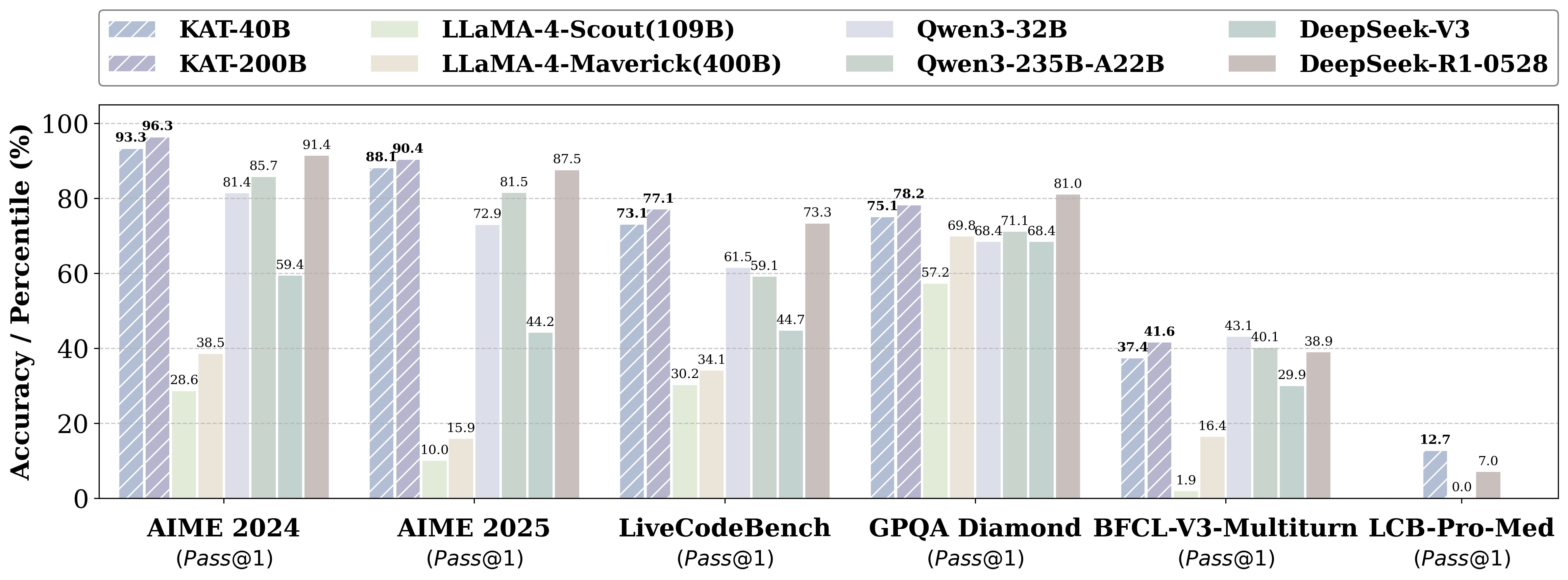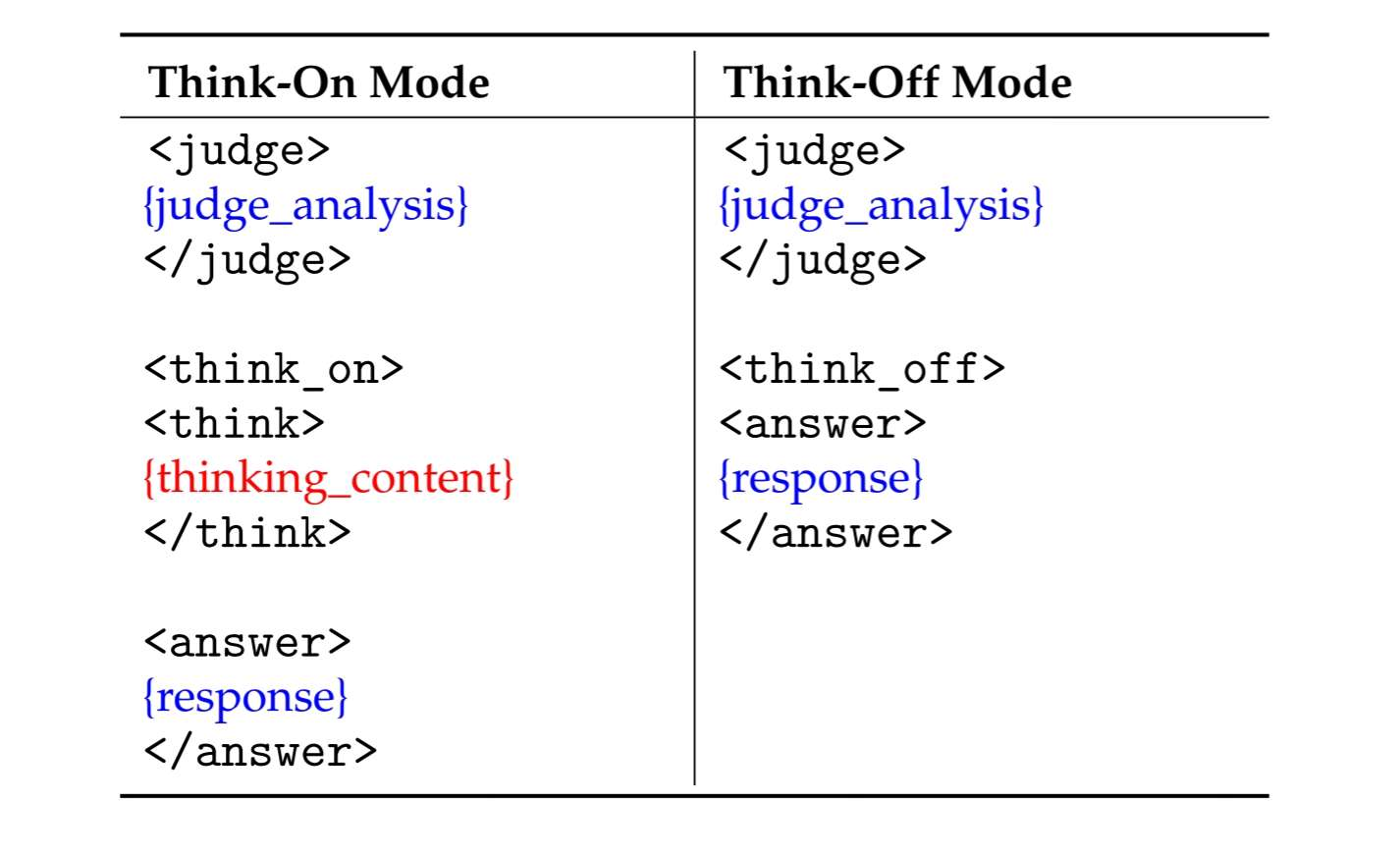新闻
- Kwaipilot-AutoThink 在专为防止数据泄露设计的挑战性基准测试 LiveCodeBench Pro 中位列所有开源模型榜首,甚至超越了 Seed 和 o3-mini 等强大的专有系统。
简介
KAT(快想-自动思考) 是一个开源大语言模型,通过学会判断何时生成显式推理链与何时直接回答,有效缓解了过度思考问题。

其发展遵循简洁的两阶段训练流程:
| Stage | Core Idea | Key Techniques | Outcome |
|---|---|---|---|
| 1. Pre-training | Inject knowledge while separating “reasoning” from “direct answering”. | Dual-regime data • Think-off queries labeled via a custom tagging system. • Think-on queries generated by a multi-agent solver. Knowledge Distillation + Multi-Token Prediction for fine-grained utility. | Base model attains strong factual and reasoning skills without full-scale pre-training costs. |
| 2. Post-training | Make reasoning optional and efficient. | Cold-start AutoThink — majority vote sets the initial thinking mode. Step-SRPO — intermediate supervision rewards correct mode selection and answer accuracy under that mode. | Model triggers CoT only when beneficial, reducing token use and speeding inference. |

数据格式
KAT以结构化模板生成响应,使推理路径清晰且机器可解析。
支持两种模式:

特殊标记
| 标记 | 描述 |
|---|---|
<judge> | 分析输入以判断是否需要显式推理过程。 |
<think_on> / <think_off> | 表示推理功能是否启用(“on”)或跳过(“off”)。 |
<think> | 当选择think_on时,标记思维链片段的开始。 |
<answer> | 标记最终面向用户答案的开始。 |
🔧 Quick Start
from transformers import AutoTokenizer, AutoModelForCausalLM
model_name = "Kwaipilot/KAT-V1-40B"
# load the tokenizer and the model
tokenizer = AutoTokenizer.from_pretrained(model_name, trust_remote_code=True)
model = AutoModelForCausalLM.from_pretrained(
model_name,
torch_dtype="auto",
device_map="auto"
)
# prepare the model input
prompt = "Give me a short introduction to large language model."
messages = [
{"role": "user", "content": prompt}
]
text = tokenizer.apply_chat_template(
messages,
tokenize=False,
add_generation_prompt=True
)
model_inputs = tokenizer([text], return_tensors="pt").to(model.device)
# conduct text completion
generated_ids = model.generate(
**model_inputs,
max_new_tokens=65536,
temperature=0.6,
top_p=0.95,
)
output_ids = generated_ids[0][len(model_inputs.input_ids[0]):].tolist()
content = tokenizer.decode(output_ids, skip_special_tokens=True).strip("\n")
print("prompt:\n", prompt)
print("content:\n", content)
"""
prompt:
Give me a short introduction to large language model.
content:
<judge>
The user's request is to provide a concise factual introduction to large language models, which involves retrieving and summarizing basic information. This task is straightforward as it only requires recalling and presenting well-known details without deeper analysis. No complex reasoning is needed here—just a simple explanation will suffice.
</judge>
<think_off>
<answer>
A **Large Language Model (LLM)** is an advanced AI system trained on vast amounts of text data to understand, generate, and process human-like language. Here’s a concise introduction:
### Key Points:
1. **Training**: Trained on diverse text sources (books, websites, etc.) using deep learning.
2. **Capabilities**:
- Answer questions, generate text, summarize content, translate languages.
- Understand context, sentiment, and nuances in language.
3. **Architecture**: Often based on **transformer models** (e.g., BERT, GPT, LLaMA).
4. **Scale**: Billions of parameters, requiring massive computational resources.
5. **Applications**: Chatbots, content creation, coding assistance, research, and more.
### Examples:
- **OpenAI’s GPT-4**: Powers ChatGPT.
- **Google’s Gemini**: Used in Bard.
- **Meta’s LLaMA**: Open-source alternative.
### Challenges:
- **Bias**: Can reflect biases in training data.
- **Accuracy**: May hallucinate "facts" not grounded in reality.
- **Ethics**: Raises concerns about misinformation and job displacement.
LLMs represent a leap forward in natural language processing, enabling machines to interact with humans in increasingly sophisticated ways. 🌐🤖
</answer>
"""
未来发布计划
展望未来,我们将发表一篇配套论文,完整记录AutoThink训练框架,内容包括:
- 冷启动初始化流程
- 强化学习(Step-SRPO)策略
- 数据筛选与奖励机制设计细节
同时,我们将开源以下资源:
- 训练资源——精选的双模式数据集和强化学习代码库
- 模型系列——包含15亿、70亿和130亿参数的模型检查点,均采用AutoThink门控机制训练

























 425
425

 被折叠的 条评论
为什么被折叠?
被折叠的 条评论
为什么被折叠?








